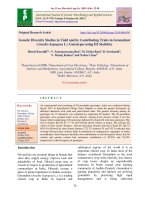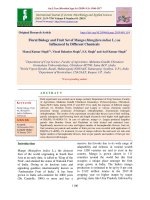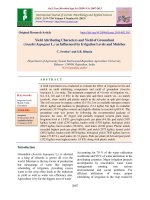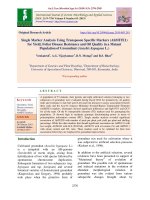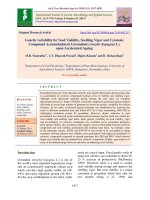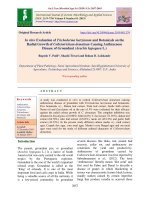Yield attributing characters and yield of groundnut (Arachis hypogaea L.) as influenced by irrigation levels and mulches
Bạn đang xem bản rút gọn của tài liệu. Xem và tải ngay bản đầy đủ của tài liệu tại đây (248.63 KB, 7 trang )
Int.J.Curr.Microbiol.App.Sci (2019) 8(1): 2607-2613
International Journal of Current Microbiology and Applied Sciences
ISSN: 2319-7706 Volume 9 Number 01 (2019)
Journal homepage:
Original Research Article
/>
Yield Attributing Characters and Yield of Groundnut
(Arachis hypogaea L.) as Influenced by Irrigation Levels and Mulches
C. Swetha* and S.R. Bhunia
Department of Agronomy Swami Keshwanad Rajasthan Agriculture University,
Bikaner- 334006. Rajasthan, India
*Corresponding author
ABSTRACT
Keywords
Irrigation levels,
Mulch, Yield,
Groundnut
Article Info
Accepted:
20 December 2018
Available Online:
10 January 2019
A field experiment was conducted to evaluate the effect of irrigation levels and
mulch on yield attributing components and yield of groundnut (Arachis
hypogaea L.) in study. The treatment comprised of 4 levels of irrigation viz.,
0.4, 0.6, 0.8 and 1.0 ETc in the main plot and three mulch viz., no mulch
(control), straw mulch and plastic mulch in the sub plot in split plot design.
The soil was poor in organic carbon (0.11%), low in available nitrogen content
(86.41 kg/ha) and medium in phosphorus (33.4 kg/ha) but high in available
potassium (337.0 kg/ha) content and slightly alkaline in reaction (pH 8.4). The
groundnut crop was grown by following the recommended package of
practices for zone- IC (hyper arid partially irrigated western plain zone).
Irrigation level at 1.0 ETc gave higher pods .per plant (44.16), pod yield (3395
kg/ha), kernel yield (2343 kg/ha), haulm yield (5530 kg/ha), biological yield
(8925 kg/ha), harvest index (38.04%), seed index (42.60 gram). Plastic mulch
recorded highest pods per plant (40.09), pod yield (2973 kg/ha), kernel yield
(2052 kg/ha), haulm yield (4870 kg/ha), biological yield (7843 kg/ha), harvest
index (37.89 %), seed index (41.31 gram). Pods per plant (44.64) and pod yield
(3523 kg/ha) were highest under 1.0 ETc along with plastic mulch.
Introduction
Groundnut (Arachis hypogaea L.) is adorned
as a king of oilseeds is grown all over the
world. Moisture is the key factor of production
but mismanage of water like improper
scheduling of irrigation, providing excess
water to the crop often leads to the reduction
in yield as well as water use efficiency also.
Agriculture is by far the biggest user of water
Accounting for 70 % of the water utilization
worldwide and 90 % of water utilization in the
developing countries. Major irrigation projects
accompanied by unscientific water water
management
running
into
serious
environmental and social problems. For
efficient utilization of water, proper
scheduling of irrigation to the crop would be
2607
Int.J.Curr.Microbiol.App.Sci (2019) 8(1): 2607-2613
on the scientific manner. To bring more area
under irrigation by using same amount of
irrigation water advanced method of irrigation
methods like drip irrigation in groundnut crop
is essential. For efficient utilization of
irrigation water, it is necessary to find out
proper scheduling of irrigation. Irrigation
scheduling based on climatological approach
(ETc) is considered as most scientific
approach as it integrates all the weather
parameters giving them natural weightage in a
given climate-plant continuum (Parihar et al.,
1976). As the soil and climatic condition are
suitable for groundnut cultivation, but due to
high
potential
evapotranspiration
and
relatively low rainfall in north western region
of India, especially the states like Rajasthan it
creates a more problem. To mitigate this
problem mulching is very important because it
prevents direct evaporation of moisture from
the soil and thus counteracts the water losses
over the soil surface. In this manner it plays
positive role in both soil and water
conservation.
Materials and Methods
Description of study area
Field experiment was conducted during Kharif
2017 at the Instructional farm, College Of
Agriculture, Swami Keshwanand Rajasthan
Agriculture
University,
Bikaner,
and
Rajasthan, India. Bikaner is situated at
28.010N latitude and 73.220E longitude at an
altitude of 234.70 meters above mean sea
level. According to National planning
commission, Bikaner falls under Agro climatic
zone XIV (Western Dry Region) of India.
According to “Agro-ecological region map”
brought out by the National Bureau of Soil
Survey and Land use planning (NBSS &
LUP), Bikaner falls under Agro-ecological
region No.2 under arid ecosystem, which is
characterized by deep, sandy and coarse
and these two are compared with plots without
loamy, desert soils with low water holding
capacity, hot and arid climate. Annual
Potential Evapotranspiration in this region
varies between 1500-2000 mm. Bikaner has
arid climate with average rainfall of about 250
mm. The soil of the experimental field was
loamy san in texture and slightly alkaline in
reaction. The soil was poor in organic carbon,
low in available nitrogen and medium in
phosphorus but high in available potassium.
Experimental design
The experiment was laid out in a split plot
design as different irrigation levels in main plots
and mulches in sub plots. The twelve treatments,
namely, 0.4 ETc irrigation level with no mulch
(I1M0), straw mulch (I1M1), plastic mulch
(I1M1), 0.6 ETc with no mulch (I2M0), straw
mulch (I2M1), plastic mulch (I2M1), 0.8 ETc
with no mulch (I3M0), straw mulch (I3M1),
plastic mulch (I3M1), and 1.0 ETc with no mulch
(I4M0), straw mulch (I4M1), plastic mulch (I4M1)
were replicated thrice . The plot size was 4.0 X
5.0 m. The groundnut variety „HNG-10‟ was
used at 100 kg/ha of seed rate. First irrigation
(25 mm) was given immediately after sowing to
ensure proper germination and subsequent
irrigations were scheduled in alternate days as
per treatment through drip system. The quantity
of water was calculated as follows:
Irrigation water (mm) = PE × Kp × Kc
Where,
PE = Pan evaporation (mm)
Kp = Pan factor
Kc = Crop factor
Pan factor (Kp) was selected from FAO
irrigation and drainage paper 24 (Crop water
requirement). During rainy days the volume of
water applied to each treatment was adjusted for
effective rainfall received. The crop factor (Kc)
for the groundnut crop for different stage is
depicted in Table 1. The soil was covered with
straw and plastic mulch as per treatment
mulch (control).
2608
Int.J.Curr.Microbiol.App.Sci (2019) 8(1): 2607-2613
Sampling and measurements
The pods per plant and kernels per pod were
manually recorded by selecting five randomly
selected plants in each plot. For seed index a
composite sample of kernels from each net
plot was drawn from the shelled pods and the
100 kernels were counted and weight in grams
and were recorded separately for each net plot
by electronic balance. The pod yield, haulm
yield and biological yield was recorded plot
wise and then converted into kg/ha.
The harvest index was worked out as per
formula advocated by Singh and Stoskoff
(1971).
Harvest
Index (%)
Economic
(kg/ha)
=
Biological
(kg/ha)
Yield
Yield
X 100
The shelling percentage was computed by
taking a composite sample of 100 gram from
the bulk of the dry pods of each net plot
randomly and shelled. The ratio of kernel to
pod weight was worked out and expressed in
per cent. The data obtained from various
characters under study were analyzed in
accordance with the “Analysis of variance”
technique suggested by Fisher (1950) for split
plot design.
Results and Discussion
Effect of
attributing
groundnut
irrigation levels
characters and
on yield
yield of
The data was recorded and analysed for
different yield attributing characters and yield
of groundnut (Table 2 and 3). In groundnut,
the increase in yield proportionatly with the
increase in irrigation level upto 1 ETc.
Irrigation level 1.0 ETc gave significantly
higher pods per plant(44.17 pods), pod yield
[3395kg/ha (Figure 1)], kernel yield (2343
kg/ha), haulm yield [5533 kg/ha (Figure 2)],
biological yield (8925 kg/ha), harvest index
(38.04%) and seed index (42.60 grams) as
compared to rest of the irrigation levels. It
might be due to the reason that at 0.4 ETc,
water availability was meager which caused
plant mortality as well as poor growth of plant
due to extreme hot climate during summer
months which resulted in poor yield.
Sripunitha et al., (2011) reported that drip
irrigation at 100 per cent potential
evapotranspiration led to a greater kernel yield
and higher kernel quality in groundnut.
Number of kernels per pod remains unaffected
due to different irrigation levels. However,
size of kernel was affected. Larger sized
kernel was obtained with full irrigation while
smaller (shrink) size obtained with irrigation
level at 0.4 ETc. This might have happened
due to lower amount of irrigation water
supplied to the crop which causes poor growth
of crop. Sezen et al., (2008) also reported that
both irrigation levels and irrigation
frequencies had significant effect on seed size
in beans.
Effect of mulch on yield attributing
characters and yield of groundnut
Plastic mulch significantly influenced yield
and yield contributing characters viz. pods per
plant (40.08), pod yield [2973 kg/ha (Figure
1)], kernel yield (2052 kg/ha), haulm yield
[4870 kg/ha Figure 2)], biological yield (7843
ka/ha), seed index and harvest index.
However, kernels per pod remained
unaffected (Table 2 and 3). The superiority of
plastic mulch and straw mulch over no mulch
could be due to their effectiveness in reducing
the evaporation losses by creating the obstacle
in external evaporability by cutting of solar
radiation falling on the earth surface. It seems
that moderate hydrothermal regimes under
mulch materials may have resulted better
development.
2609
Int.J.Curr.Microbiol.App.Sci (2019) 8(1): 2607-2613
Table.1 Crop factor for groundnut throughout the crop growth period
Sr. No.
Month and Days
Stages
Crop factor (KC)
1
June (21-30)
Initial
0.5
2
July (1-10)
Initial
0.5
3
July (11-30)
Crop development
0.8
4
July (31)
Mid
1.1
5
Aug. (1-31)
Mid
1.1
6
Sept. (1-30)
Mid
1.1
7
Oct. (1-24)
Final
0.7
Table.2 Effect of Irrigation levels and mulch on pods per plant, kernels per pod, pod yield,
haulm yield and biological yield of groundnut
Treatments
Pods/plant Kernels/pod Pod
Kernel
Haulm
Biological
yield
yield
yield
yield (kg/ha)
(kg/ha)
(kg/ha)
(kg/ha)
Irrigation
levels
0.4 ETc
29.00
1.98
2025
1391
3442
5467
0.6 ETc
37.00
2.02
2631
1816
4311
6942
0.8 ETc
41.34
2.11
3074
2122
5042
8117
1.0 ETc
44.17
2.13
3395
2343
5530
8925
SEm±
0.24
0.02
24
16
43
66
CD (P=0.05)
0.84
NS
84
56
147
229
No mulch
35.08
2.00
2561
1762
4264
6826
Straw mulch
38.47
2.05
2810
1939
4611
7421
Plastic mulch
40.08
2.13
2973
2052
4870
7843
SEm±
0.11
0.01
5
4
11
16
CD (P=0.05)
0.33
NS
16
12
34
48
Mulching
2610
Int.J.Curr.Microbiol.App.Sci (2019) 8(1): 2607-2613
Table.3 Effect of irrigation levels and mulch on harvest index, seed index and shelling
percentage of groundnut
Treatments
Harvest Index (%)
Shelling
percentage (%)
Seed index
(gram)
0.4 ETc
36.98
68.79
39.06
0.6 ETc
37.89
68.96
40.45
0.8 ETc
37.88
69.29
41.65
1.0 ETc
38.04
69.39
42.60
SEm±
0.06
0.06
0.14
CD (P=0.05)
0.21
NS
0.47
No mulch
37.40
68.67
40.43
Straw mulch
37.82
69.09
41.08
Plastic mulch
37.89
69.55
41.31
SEm±
0.03
0.07
0.05
CD (P=0.05)
0.10
NS
0.15
Irrigation
levels
Mulching
SEm± - Standard Error Mean, CD- Critical difference
Table.4 Interaction effect of irrigation levels and mulching on pods per plant and pod yield of
groundnut
Treatments
Pods per plant
0.4
ETc
Pod yield (kg/ha)
0.6ETc 0.8ETc 1.0ETc 0.4 ETc 0.6ETc 0.8ETc
1.0
ETc
No mulch
25.00
32.00
39.67
43.67
1760
2345
2890
3250
Straw mulch
30.17
38.67
40.87
44.17
2053
2687
3087
3412
Plastic mulch
31.83
40.33
43.50
44.67
2262
2860
3247
3523
SEm±
0.43
21
CD*(P=0.05)
1.30
62
SEm±
2.86
79
CD**(P=0.05)
8.58
236
CD*- CD for mulching at the same level of irrigation levels,
CD**- CD for irrigation levels at the same or different levels
2611
Int.J.Curr.Microbiol.App.Sci (2019) 8(1): 2607-2613
Figure.1 Effect of irrigation levels and mulch on pod yield of groundnut
Figure.2 Effect of irrigation levels and mulch on haulm yield of groundnut
Thus, the improvement in yield attributes of
groundnut under mulching practices
ascribed to better availability of moisture
and moderation of soil temperature which
led to greater uptake of nutrients and
reduced number of days taken to meet
required heat unit for proper growth and
development of plants and ultimately the
yields. The findings of present investigation
are closely conformed by the Yadav (2006)
in mustard and Eid et al., (2013) in soybean.
2612
Int.J.Curr.Microbiol.App.Sci (2019) 8(1): 2607-2613
conditions. Agricultural Sciences,
4(5): 249-261.
Moniruzzaman, M., Faisal, S.M., Sarkar,
M.A.R., Hossain, Afsar Ali M. and
Talukder, M.A.H. (2007). Effects of
irrigation and different mulches on
yield of profitabiliity of cauliflower.
Asian Journal of Plant Sciences, 6:
338-343.
Parihar S. S, Khera K. L, Sandhu, K. S and
Sandhu, B. S. (1976). Comparison of
irrigation schedule based on pan
evaporation and growth stages in
wheat. Agronomy Journal, 68: 650653.
Sezen, B.K., Manda,K. and Bag, N.(2008).
Effect of mulching and roe spacing on
growth seed yield and oil yield of
rainfed Niger (Guizotia abyssinica) in
red and lateritic acid belt of West
Bengal. Indian Journal of Agricultural
Sciences, 78(6): 557-559.
Sripunitha,
A.,
Sivasubramaniam,K.,
Manikandan, S., Selvarani, K. and
Krishna Shyla K.K. (2011). Sub
surface drip irrigation studies on seed
and field quality of groundnut.
Legume Research, 34(4): 311-313.
Yadav, R.D., Pareek, R.G., Yadav, R.L.
(2006). Effect of mulching and
sulphur on growth and yield of
mustard [Brassica juncia (L.) Czern
and Cosson] under varying levels of
irrigation. Journal of Oilseeds
Research, 23(2): 219-221.
Interaction effect of irrigation levels and
mulch on yield and yield attributing
characters of groundnut
The interaction of different irrigation levels
with mulches was significant in pods per plant
and pod yield (Table 4). Highest pods per
plant was recorded under plastic mulch at
irrigation level of 1.0 ETc (44.67 pods plant-1),
It might be due to maintenance of water
regime at nearer to field capacity in soil under
irrigation under higher water regime
throughout the growing period which
enhanced the pod development with mulch at
1.0 ETc irrigation levels. Thus, highest pod
yield was recorded under 1.0 ETc irrigation
level along with plastic mulch. These results
are in line with those reported by
maniruzzaman et al., (2007).
From the experimental results it may be
inferred that in the prevailing agroclimatic
condition, groundnut can yield successfully
with irrigation scheduled at 1.0 ETc along
with mulch. This combination will produce
maximum yield potential of groundnut in
areas where rainfall level is less and potential
evapotranspiration is more.
References
Eid, Abdelraouf Ramadan., Bakry. Ahmed
and Taha, Moamen Hamed. (2013).
Effect of pulse drip irrigation and
mulching systems on yield, quality
traits and irrigation water use
efficiency of soybean under sandy soil
How to cite this article:
Swetha, C. and Bhunia, S.R. 2019. Yield Attributing Characters and Yield of Groundnut
(Arachis hypogaea L.) as Influenced by Irrigation Levels and Mulches.
Int.J.Curr.Microbiol.App.Sci. 8(01): 2607-2613. doi: />
2613
![Growth and yield of Ashwagandha [Withania somnifera (L.)] as influenced by different intercropping system in Kymore plateau of Madhya Pradesh](https://media.store123doc.com/images/document/2020_01/09/medium_vsb1578562778.jpg)
